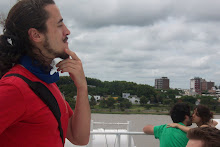“The Educator’s Guide to the Read/Write Web”
by Will Richardson
by Will Richardson
I. Overview:
In “The Educator’s Guide to the Read/Write Web,” Will Richardson discusses additions to the Internet environment that allow people to easily publish writing and audio broadcasting and how these new developments are changing the way some people teach. After introducing blogs, wikis, feeds, social bookmarking, and podcasting, Richardson describes how he thinks that teachers should respond to these new media. He gives many suggestions and examples, three of which seem to be central to his point of view:
- teachers should have students use these technologies to publish their work to a wider audience
- teachers should show students how to evaluate information from the web, and
- educators should incorporate these technologies into their classroom by increasing the non-textbook materials used in their classes and shifting their role from teaching content to guiding students to learn from online sources and experts.
II. Quotes:
Audience
“The awareness of even a small audience can significantly change the way a student approaches writing and other school assignments. It’s the difference between handing a piece in to a teacher and publishing it.”
“Students create online, reflective, interactive portfolios of their work to share with worldwide audiences.”
Scrutinizing Sources
“We must teach students how to actively question and evaluate published information instead of passively accepting it as legitimate.”
“Google regularly scans in information from more than 50 million books from the world’s biggest research libraries, and a new blog is created every two seconds. Literate internet users need strategies for sorting out, storing, and using relevant information from this outpouring.”
Examples
“For example, at Hunterdon High School in Flemington, New Jersey, where I teach, students have used blogs to collaborate with authors of the books they are reading in literature classes; to contact professional mentors in journalism classes; and to communicate with high schoolers from Krakow, Poland, as part of a unit on the Holocaust.”
“A student doing a project on global warming, for example, can create RSS feeds that will bring him or her the latest research on the topic almost as soon as it is published.”
“Students across the United States are podcasting audio tours of local museums and points of interest, weekly news programs about their classrooms, oral histories and interviews, and more.”
III. Reflection: The Novelty Cult
Real World Scene: I’m driving six or seven students home in the company Suburban after dance practice. The radio is playing a rock song.
Teenage Boy: Oh, this song has an awesome music video! Have you guys seen it?
Teenage Girl: You still watch music videos?!?
Teenage Boy: (quickly, trying to maintain his coolness) Only on the computer! I watch them online!
Teenage Girl: (satisfied that Boy has not lost his coolness) Oh, okay.
Does newer necessarily mean better? This young Girl was shocked that Boy would do something as 90’s as watching music videos on television, but could relate as soon as he said he watched them online. The content would likely be unchanged whether it was on television or online, but somehow the medium made all the difference. While I agree with much of what Will Richardson has to say in “The Educator’s Guide to the Read/Write Web,” I believe that at some level he shares the belief that my students expressed in the above situation that newer is inherently better. Here are two examples taken from the text:
“Digital tools allow students to easily work together outside school—for example, collaborating on projects through instant messaging or text messaging on phones.”
True. There is also another tool that allows students to easily work together outside school: a telephone. Or, to go even lower tech, they could meet somewhere. Newer technology doesn’t magically instill motivation or organization into students.
“With millions of knowledgeable people posting blogs, for example, students may find scientists, writers, or researchers willing to guide their study of a topic who have more content-area expertise than a classroom teacher.”
True. Students MAY find a scientist, researcher, or writer who has enough time, energy, and willingness to guide them through a topic online. Teachers have also been bringing in guest speakers and going on field trips to visit outside experts at museums, national parks, etc. for quite a long time. The difficulty, whether using the Internet or going out in the real world, is making the right contacts, finding experts who will donate their time, and organizing everything.
That being said, I fully agree with Richardson that because we live in an information environment that can at times be overwhelming, educators must teach students to evaluate, sort, store, and use information wisely. Having students publish their work online may also be valuable as a motivational tool, although I think that we need to realistically look at who is reading the blogs and wikis and listening to the podcasts that students would create. For example, who is going to read this blog? The worldwide audience that people refer to? Or will it just be the teacher, and maybe one or two other students in the class?
I found the most useful part of the article to be the examples that Richardson gave of teachers using this technology in the classroom. These led to a flurry of ideas about how I could incorporate these tools into my teaching in appropriate ways. After all, even though I think that novel doesn’t necessarily mean superior, it appears that many of my students are excited about new media tools.

No comments:
Post a Comment